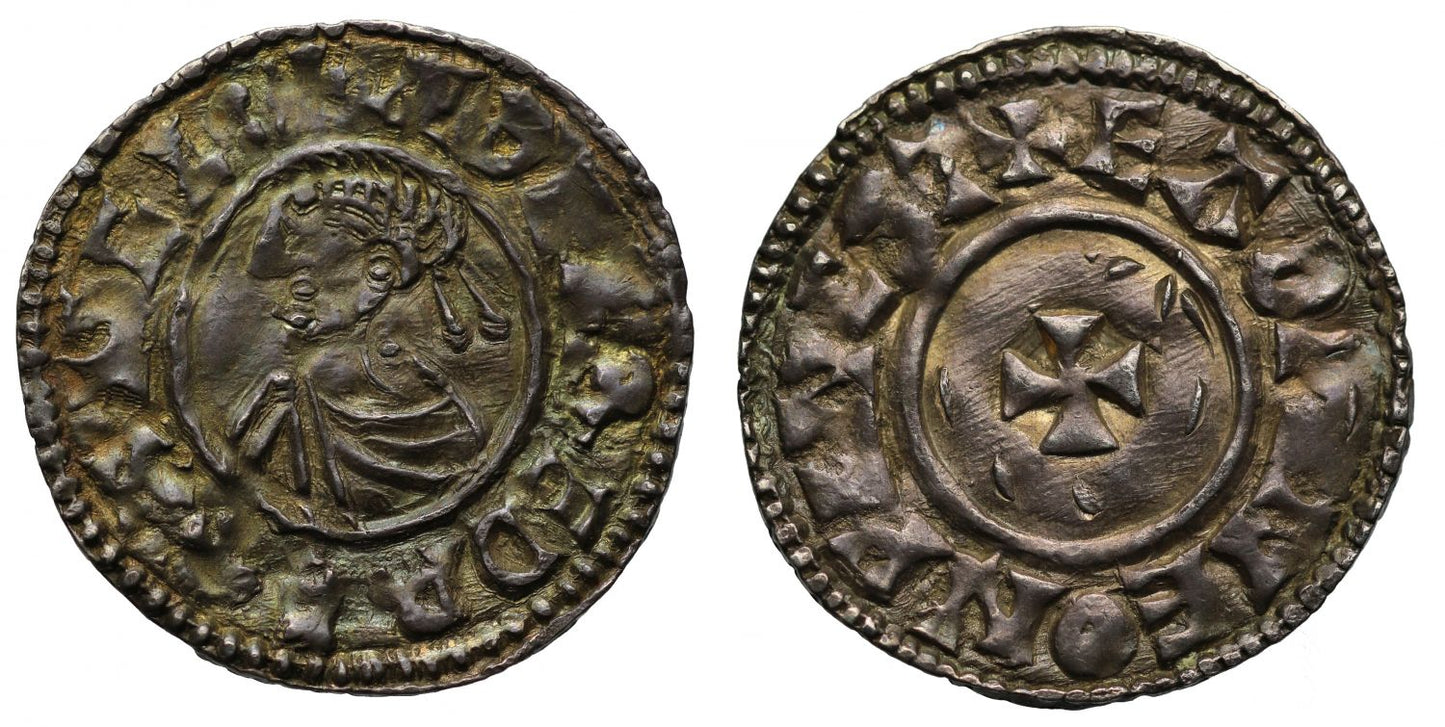FAQs
What makes a coin valuable?
I have coins to sell, what’s the next step?
How will my purchases be shipped?
What happens if I’m not entirely happy with my purchase?
Aethelred II, Penny, last small cross type, Winchester Mint, moneyer Eadwine
Aethelred II (978-1016),silver Penny, last small cross type (c.1009-17), Winchester Mint, Moneyer Eadwine, diademed and draped bust left within linear circle, Latin legend surrounding, +ÆÐELRED REX ANGLI, rev. small cross pattée at centre, linear circle with legend surrounding, +EADPINE ON PINCST, weight 1.24g (BMC I, 351; BEH 2172; SCBI 7:1387 Copenhagen; N.777; S.1154).Toned with peck marks both sides, otherwise very fine.
North lists 73 named mints in operation during the reign of Aethelred II with a further 14 unallocated. According to North Winchester operates with 44 moneyers across all types.
Though Aethelred enjoyed such a long reign he was known as "The Unready" literally meaning ill-counselled from a history of bad advice and decision making. Born circa 967 Aethelred was supported by his mother and partisans that were led by Earl Aelfhere of Mercia; ascending the throne at no more than 12 years of age after the murder of his Half-Brother Edward at Corfe. The influential Aelfhere having died in 983 meant Aethelred became more vulnerable, and the Vikings began to start their raids once again. Aethelred chose to pay off the raiders rather than resist, becoming known for giving such ransoms payments willingly. This meant many hundreds of thousands of coins ended up being taken to Scandanavia where they were hoarded and why much of the coinage that survives today often exhibits "peck marks" where the Viking bankers have inserted a knife point to make sure the metal quality was good. The harrying continued until Swein Forkebeard held a great swathe of England by 1013, and Aethelred was under threat in London retreating to the Isle of Wight. England submitted to Swein but he died suddenly on the 2nd February 1014 at Gainsborough giving Aethelred the advantage and driving the Vikings out. Canute the second son of Swein, returned to attack in 1015 and by early 1016 was marching on Mercia, Aethelred however passed away on 23rd April 1016 in London at around the age of 52 just as his second son Edmund was moving south to link up with the army. Edmund was elected King, but the army was his priority, and after winning a few battles suffered a defeat at Ashingdon on 18th October 1016. He retreated possibly wounded to West Mercia and negotiated a treaty giving him rule of Wessex. However, Edmund died in Oxford on the 30th November 1016 giving control to Canute.
The City of Winchester on the River Itchen in Hampshire was the Capital of the West Saxon Kingdom and seat of their bishop and mentioned in the Burghal Hidage. The Royal Treasury was here with coinage perhaps struck here as early as the reign of Beorhtric, the first time the mint name appears is on a Penny of Alfred the Great. The town was stormed by Danes in 860 and submitted without resisting to Swein in 1013. Henry of Blois was Bishop of Winchester in the reign of Stephen and the town visited by Matilda proclaimed as "Lady and Queen of England" in 1141, though she later had to flee as it was burnt. Later King John was driven from Winchester in 1216.
The legends translate as "Aethelred King of the English" on obverse and "Eadwine of Winchester" on the reverse.
Provenance:
Ex Baldwin Auction 99, 4th May 2016, lot 957.
Ex Collection of an English Doctor, part one, Sovereign Rarities, London, March 2022.
FAQs
What makes a coin valuable?
I have coins to sell, what’s the next step?
How will my purchases be shipped?
What happens if I’m not entirely happy with my purchase?













